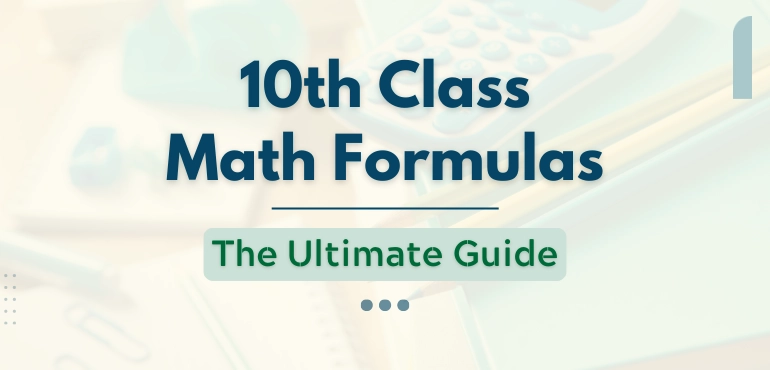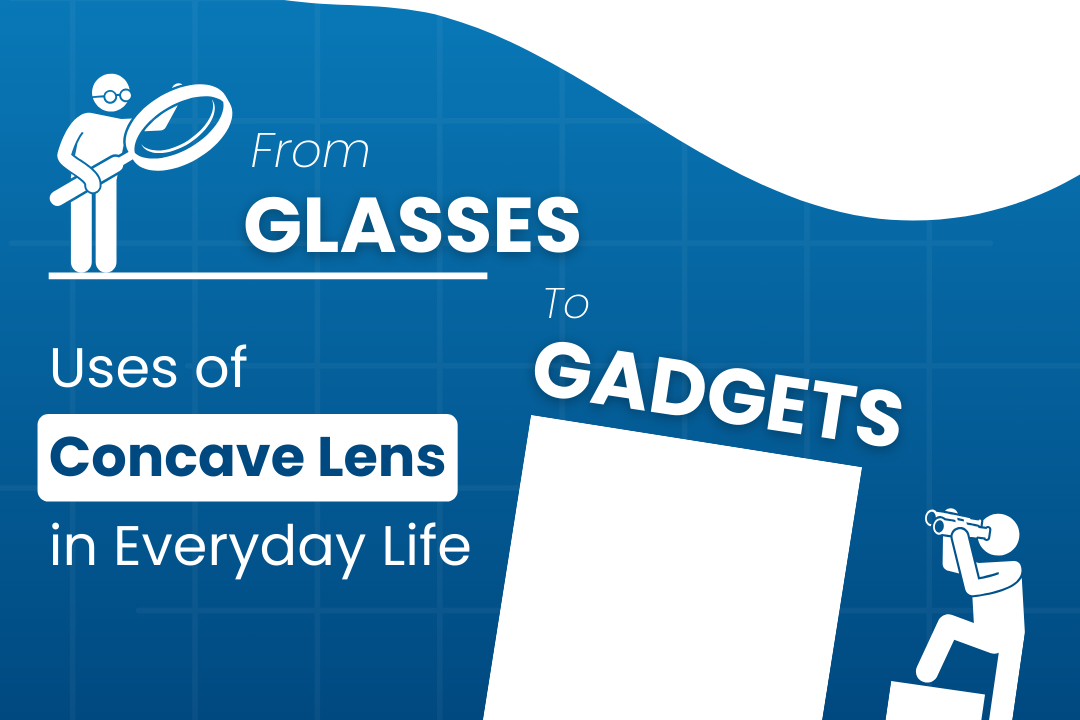
Mathematics has always been a nightmare for many students because of some simple mistakes. One such mistake is not paying enough attention to the important formulas in each chapter. Investing time in learning the formulas is definitely worth it as it saves a lot of time while solving the problems. In 10th class math exam preparation the first priority should be given to learning formulas and in an attempt to make your work easier, we have compiled the list of all the 10th class math formulas for each of the chapters. We hope you will find this resource helpful.
Chapter-1: Real Numbers
Real numbers formulas for class 10th act as a foundation for some of the complex chapters that students are supposed to study in their higher education. Understand the most important formulas from the real numbers chapter given below and try to figure out their practical implementation by using them in the exercises provided in your textbook.
Laws of logarithms:
If a, x and y are positive real numbers and a ≠ 1, then
(i) loga xy = loga x + loga y
(ii) loga x/y = loga x – loga y
(iii) loga x^m= m loga x
(iv) loga 1 = 0
(v) loga a= 1
Chapter-2: Sets
It’s one of the scoring chapters in class 10th board exams and students shouldn’t be missing this opportunity of scoring big. The sets’ formulas might look quite theoretical but they are actually not. Students need an analytical mind to understand and implement the following formulas.
(i) A is a subset of B if ‘a’ is an element of A implies that ‘a’ is also an element of B. This is
written as A⊆ B if a∈A => a∈B, where A, B are two sets.
(ii) Two sets, A and B are said to be equal if every element in A belongs to B and every
element in B belongs to A.
(iii) The difference of two sets A, B is defined as A – B
A – B = {x: x ∈ A and x ∉ B}
Chapter-3: Polynomials
Polynomials class 10 formulas will continue to appear for a very long time if the student pursues his education in the science stream with mathematics as one of the subjects. Polynomial formulas will also help those preparing for competitive exams like SSC(Staff Selection Exams) bank exams as well. So, don’t miss the following two important formulas from the polynomials chapter of class tenth mathematics.
What is the Quadratic Polynomial Formula?
If a and b are the zeroes of the quadratic polynomial ax² + bx + c, a ≠ 0, then α+β= -b/a, αβ = c/a.
What is the Cubic Polynomial Formula?
If α,β,γ are the zeroes of the cubic polynomial ax³ + bx² + cx + d, a≠0, then
- α+β+γ= -b/a
- αβ+βγ+γα = c/a
- αβγ = -d/a
Chapter-4: Pair of Linear Equations in Two Variables
If there are two linear equations with same two variables in each of them, they are called as a pair of linear equations in two variables. This chapter has a good weightage in the class 10th board exams and here are some of the important relations that students need to remember.
There exists a relation between the coefficients and the nature of the system of equations.
- a1/a2 ≠ b1/b2 then the pair of linear equations is consistent.
- a1/a2 = b1/b2 ≠ c1/c2 then the pair of linear equations is inconsistent.
- a1/a2=b1/b2=c1/c2 then the pair of linear equations is dependent and consistent.
Chapter-5: Quadratic Equations
For solving quadratic equations students must be aware of some basics like the standard form of a quadratic equation and the formulas for finding the roots of a quadratic equation which we are going to discuss now.
The standard form of a quadratic equation is ax² + bx + c = 0 (a≠0). Here condition a≠0 is extremely important. If “a” equals zero, the highest power will be ‘one’ in bx1 + c = 0 which doesn’t make it a quadratic equation.
Quadratic equation roots formula:
The roots of a quadratic equation ax² + bx + c = 0 (a≠0) are given by (-b±√(b²-4ac))/(2a) provided b² – 4ac ≥ 0. This quadratic formula is also known as the Sridharacharya formula, an Indian mathematician who was born in 870 AD.
Now, let’s check out some important conditions to determine what kind of roots a quadratic equation has.
A quadratic equation ax² + bx + c = 0 (a≠0) has
(a) two distinct real roots if b² – 4ac > 0,
(b) two equal roots (i.e., coincident roots), if b² – 4ac = 0, and
(c) no real roots, if b² – 4ac < 0.
Chapter-6: Progressions
Solving problems from the Progressions chapter demands both arithmetic and logical ability. Students who love math will definitely enjoy solving problems from the progressions chapter. To seamlessly find solutions to the problems in Progressions, one must be aware of the following important formulas.
Arithmetic Progression Formulas:
(i) The sum of the first n terms of an AP is given by: S= (n/2) [2a+(n-1)d]
(ii) If ℓ is the last term of the finite AP, say the nth term, then the sum of all terms of the AP is given by, S = (n/2) (a+ℓ)
(iii) If ℓ is the last term of the finite AP, say the nth term, then the sum of all terms of the AP is given by, S = (n/2) (a+ℓ)
Terminology: a is the first term, d is a common difference, n is the number of terms, an is the nth term, and ℓ is the last term.
Geometric Progression Formulas:
(i) nth term of a Geometric Progression is given by an = tn = ar ^ (n-1)
(ii) Sum of n terms of a Geometric Progression is given by Sn = a[(r ^ n– 1)/(r – 1)] if r ≠ 1 and r > 1
Terminology: a is the first term, r is the common ratio, n is the number of terms
Harmonic Progression Formulas:
The nth term of a harmonic progression is given by 1/[a+(n-1)d]
Where a is the first term, d is the common difference, n is the number of terms in AP.
The Sum of the n terms in a Harmonic Progression:
Sn = (1/d) ℓn { 2a+(2n-1)d/2a-d}
Where ℓn is the natural algorithm, a is the first term, n is the total number of terms, and d is the common difference.
Chapter-7: Coordinate Geometry
While solving the problems of coordinate geometry, students should pay utmost attention to the calculation as a simple mistake in any step of the solution can cost them the entire solution. Along with that remembering all the Coordinate geometry class 10 formulas is quite burdensome but it’s crucial to do so to accurately solve the problems of this chapter.
Distance formula in Coordinate Geometry:
The distance between two points P(x1,y1 ) and Q(x2, y2) is √(x2-x1)²+(y2-y1)²
Coordinate Geometry Midpoint Formula:
If (x1, y1 ) and (x1 , y2 ) are coordinates of two points, and the coordinates of another point which equidistant from these two points can be found using the formula, [(x1+x2)/2, (y1+y2)/2]
Circle Formula Coordinate Geometry:
In a circle, if we suppose, (h,k) as coordinates of the center and r is the radius of the circle, then the equation of the circle formula is given by (x – h)²+ (y – k)² = r²
Along with these three important formulas, let’s check out some other formulas from coordinate geometry class tenth that can help you score big in your board exams.
(i) The distance of a point P(x, y) from the origin is √x²+y²
(ii) The distance between two points (x1, y1 ) and (x1 , y2 ) on a line parallel to Y-axis is |y2 – y1 |
(iii) The distance between two points (x1, y1 ) and (x2 , y1 ) on a line parallel to X-axis is |x2 – x1 |
(iv) Area of a triangle is given by ‘Heron’s Formula’ as
A= √(s-a)(s-b)(s-c), where s= (a+b+c)/2 where a,b,c are three sides of a triangle ABC.
(v) The centroid of a triangle is the point of intersection of its medians. Hence the coordinates of the centroid are [(x1+x2+x3)/3, (y1+y2+y3)/3] where (x1, y1 ) (x2, y2 ) and (x3 , y3 ) are the vertices of the triangle.
Chapter-8: Similar Triangles
Proving similar triangles is quite an easy task if you are aware of some important concepts like AAA, SSS, and SAS similarity. Let’s understand the definitions of each of them but be aware that these concepts can easily be understood when they were applied. So make sure to apply the following conditions to the problems given in your textbook.
(i) AAA Similarity: In two triangles, if corresponding angles are equal, then their corresponding sides are in the same ratio and hence the two triangles are similar.
(ii) SSS Similarity: In two triangles, if the corresponding sides are in the same ratio, then their corresponding angles are equal and hence the triangles are similar.
(iii) SAS similarity: If one angle of a triangle is equal to one angle of another triangle and the including sides of these angles are in the same ratio, then the triangles are similar.
(iv) Pythagorean Theorem: In a right triangle, the square of the hypotenuse is equal to the sum of the squares of the other two sides.
(v) Angle Sum Property: If two angles of a triangle are equal to the two angles of another triangle, then the third angles of both triangles are equal by the angle sum property of the triangle.
Chapter-9: Tangents and Secants to a Circle
This is yet again another scoring chapter in the tenth class mathematics exam. Concepts in geometry are very important because you will find a hard time in your higher studies if you are not familiar with the basics of these concepts.
(i) Area of a segment of a circle = Area of the corresponding sector – Area of the corresponding triangle.
(ii) The lengths of the two tangents from an external point to a circle are equal.
Chapter-10: Mensuration
The best part about the menstruation chapter is that you can use these class 10th mensuration formulas to measure the volumes and surface areas in real-life scenarios. So, have a look at all the class 10th mensuration formulas given below.
Cuboid:
(i) Lateral Surface Area = 2h(l+b)
(ii) Total Surface Area = 2(lb+bh+hl)
(iii) Volume = lbh
Cube:
(i) Lateral Surface Area = 4a²
(ii) Total Surface Area = 6a²
(iii) Volume = a³
Prism:
(i) Lateral Surface Area = Perimeter of Base x Height
(ii) Total Surface Area = Lateral Surface area + 2(Area of the end surface)
(iii) Volume = Area of Base x Height
Cylinder:
(i) Lateral Surface Area = 2πrh
(ii) Total Surface Area = 2πr(r+h)
(iii) Volume = πr²h
Pyramid:
(i) Lateral Surface Area = ½(Perimeter of Base)x Slant Height
(ii) Total Surface Area = Lateral Surface Area + Area of the Base
(iii) Volume = ⅓(Area of Base)x height
Circular Cone:
(i) Lateral Surface Area = πrℓ
(ii) Total Surface Area = πr(ℓ+r)
(iii) Volume = ⅓πr²h
Sphere:
(i) Lateral Surface Area = πrℓ
(ii) Total Surface Area = πr(ℓ+r)
(iii) Volume of = ⅓πr²h
Hemishpere:
(i) Lateral Surface Area = πrℓ
(ii) Total Surface Area = πr(ℓ+r)
(iii) Volume = ⅓πr²h
Chapter-11: Trigonometry
There will be many concepts based on trigonometry in class 11th and class 12th. So, if you don’t focus on practicing these concepts, you will not only lose marks in the class 10th board exams but may also lose interest in mathematics in the classes 11th and 12th as many concepts there are based on these foundational concepts. If you choose MPC in Intermediate after the class tenth, you will find a wide range of advanced concepts related to trigonometry. So it’s extremely crucial to have a good command of the class 10th trigonometry which is not possible without familiarizing yourself with the following formulas.
Trigonometric Values Table:
| θ | 0° | 30° | 45° | 60° | 90° | 180° |
|---|---|---|---|---|---|---|
| Sin | 0 | 1/2 | 1/√2 | √3/2 | 1 | 0 |
| Cos | 1 | √3/2 | 1/√2 | 1/2 | 0 | -1 |
| Tan | 0 | 1/√3 | 1 | √3 | ∞ | 0 |
| Cosec | ∞ | 2 | √2 | 2/√3 | 1 | ∞ |
| Sec | 1 | 2/√3 | √2 | 2 | ∞ | -1 |
| Cot | ∞ | √3 | 1 | 1/√3 | 0 | ∞ |
Important Trigonometric Relations:
(i) sin (90° – A) = cos A, cos (90° – A) = sin A
(ii) tan (90° – A) = cot A, cot (90° – A) = tan A
(iii) sec (90° – A) = cosec A, cosec (90° – A) = sec A
(iv) sin²A + cos²A = 1
(v) sec²A – tan²A = 1 for 0° < A < 90°
(vi) cosec²A – cot²A = 1 for (0° < A < 90°)
Chapter-12: Applications of Trigonometry
Once you get your basics strong in the trigonometry chapter, it’s time to understand the applications of those concepts with real-life examples. This chapter is going to be a lot of fun as we can actually do it practically in our day-to-day lives if we can just find the angle of elevation.
Here are some important conditions from applications of Trigonometry.
(i) The line of sight is the line drawn from the eye of an observer to a point on the object
being viewed by the observer.
(ii) The angle of elevation of the object viewed, is the angle formed by the line of sight
with the horizontal when it is above the horizontal level, i.e., the case when we raise
our head to look at the object.
(iii) The angle of depression of an object viewed is the angle formed by the line of sight
with the horizontal when it is below the horizontal level, i.e., the case when we lower
our head to look at the object.
Chapter-13: Probability
This is one of the easiest and most fun chapters in the class 10th mathematics. The purpose of this concept is to predict how likely an event will occur it’s a theoretical concept and it gives accurate results in real-life situations as well if we experiment with a significantly higher number of trials. Look at these important class 10th probability formulas to not miss an opportunity to score easily in class 10th mathematics board exams.
(i) The theoretical (classical) probability of an event E, written as P(E), is defined as P (E) = [Number of outcomes favorable to E] / [Total number of all possible outcomes of the experiment]
(ii) The probability of an event E is a number P(E) such that 0 ≤ P (E) ≤ 1
Chapter-14: Statistics
Statistics is such a chapter that can’t be dealt without knowing the relevant formulas. In addition to that you need to take exceptional care while carrying out calculations. If you are someone who loves to analyze data and is interested in pursuing a career in areas like data science, this chapter acts as a strong foundation. This chapter lays a good foundation for those who want to pursue a career in finance and accountancy with the MEC course after the tenth. Check out our blog on MEC in intermediate, if you want to know more about that course and the career opportunities.
Here is the list of Statistics formulas for class tenth from the statistics chapter.
(i) Formulas for the mean for grouped data:
(a) The direct method: x̅ = (Σ fi xi) / (Σfi)
(b) The assumed mean method: x̅ = a + (Σ fi di) / (Σfi)
(c) The step deviation method: x̅ = a + [Σ fi ui/Σfi] * h
(ii) The mode for grouped data can be found by using the formula:
(iii) Mode: ℓ +{ [f1-f0] / [2f1-f0-f2]} * h
(iv) The median for grouped data is formed by using the formula:
Median = ℓ + [(n/2-cf) / f] * h
We hope you found this blog post presenting formulas from all chapters of the class 10th mathematics helpful. As we all are aware, knowing formulas is just one side of the coin and the real success lies in its application. So, we strongly recommend you first understand these formulas and practice by applying them to the questions in your textbook. This way, you will be able to lay a strong foundation for your success in higher studies.
Download PDF for Class 10th Maths Formulas
FAQs:
The expanded forms of AP, GP, and HP are Arithmetic Progression, Geometric Progression, and Harmonic Progression respectively. These are the concepts discussed in the Progressions chapter of class tenth mathematics.
By having a glance at the previous year’s question paper of TS class tenth mathematics, there are two questions covered from each of the Trigonometry and applications of trigonometry chapters in the six mark questions section. By getting familiar with some basic trigonometry formulas, you can score twelve marks in just one section. We are not saying that this chapter is important but letting you know how to analyze the previous papers to decide which chapters should be given more priority.
Trigonometry, Statistics, Geometry, and Polynomials, are some of the important topics based on which there will be advanced concepts in higher education. However, it’s important to have a strong arithmetic foundation from class sixth itself to enjoy the essence of mathematics in higher education.








